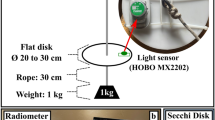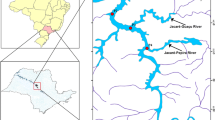Abstract.
Nitrate and nitrite solar actinometers or chemical ‘light meters’ were used to quantify light doses in photochemical and photobiological experiments involving dimethylsulfide (DMS) and dimethylsulfoniopropionate (DMSP) cycling. Light doses were calculated based on the photochemical production of salicylic acid (SA) from benzoic acid in these actinometers, with SA quantified by either spectrofluorometry or high performance liquid chromatography. Nitrate and nitrite actinometers were modified for deployment at low temperatures in Antarctic waters by addition of sodium chloride as a freezing point depressant. The addition of salt did not affect the solar response of the actinometers; however, the solar response did change slightly with latitude. In the Antarctic, peak response wavelengths (and bandwidths) for the Mylar D-wrapped actinometers in quartz tubing were 326 nm (319 – 333 nm) and 353 nm (325 – 380 nm) for nitrate and nitrite, respectively, and these were 2 – 5 nm blue shifted compared to the peak response wavelengths and bandwidths observed in the Sargasso Sea. Excellent agreement was observed when comparing the integrated irradiance determined with the actinometers to that determined with a spectroradiometer. Likewise, diffuse attenuation coefficients for downwelling irradiance (Kd(λ)) calculated from water column actinometer measurements agreed well with Kd(λ) values calculated from irradiance measurements determined with a Biospherical PUV-511 profiling radiometer. Actinometers were used to measure light doses in experiments involving DMS and DMSP transformations during several field campaigns in the Ross Sea, Antarctica and the Sargasso Sea. Based on actinometer measurements, it was determined that DMS photolysis was dependent on UV irradiation between approximately 325 – 380 nm, while biological consumption rates of DMS and DMSP were inhibited by radiation at wavelengths less than approximately 333 nm. When DMS photolysis rate constants were expressed in terms of light dose rather than time, it was possible to 1) directly determine photolysis rate constants in the water column and 2) directly compare photolysis rate constants across diverse oceanographic regions.
Similar content being viewed by others
Author information
Authors and Affiliations
Corresponding author
Additional information
Received: 17 July 2006; revised manuscript accepted: 21 April 2007
Rights and permissions
About this article
Cite this article
Kieber, D.J., Toole, D.A., Jankowski, J.J. et al. Chemical “light meters” for photochemical and photobiological studies. Aquat. Sci. 69, 360–376 (2007). https://doi.org/10.1007/s00027-007-0895-0
Published:
Issue Date:
DOI: https://doi.org/10.1007/s00027-007-0895-0




